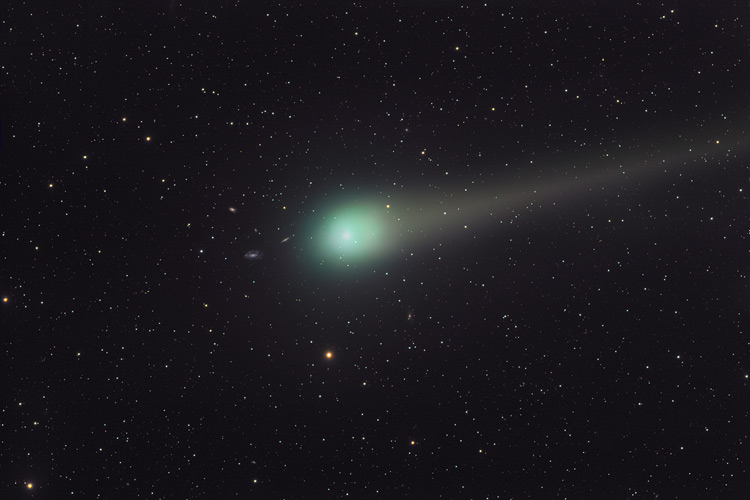
clic here for 42% size 1681 x 1121 (330 kB)
clic here for 70% size 2801 x 1868 (875 kB)
Comet C/2007 N3 (Lulin) was discovered by Quanzhi Ye, a student (age 19) at Sun Yat-sen University in mainland China, as an apparently asteroidal object on images taken by Chi Sheng Lin (National Central University, Taiwan) with a 16-inch telescope at Lulin Observatory in Taiwan on the night of July 11, 2007.
TEC-140 APO refractor with TEC flattener at f/7
About this Image
On February 26 Comet Lulin was located directly opposite in the sky from the Sun at a distance of some 62 million kilometers.
The comet now already has passed more than 180 degrees around from the Sun and is visible nearly all night long, it keeps on moving on the sky 5 degrees per night. The central coma of the comet is appearing cyan, a color likely indicating ionizised cyanic and organic carbon gases. The pale yellow dust tail, reflecting sunlight, is visible to the right far beyond the limits of this 2 degree wide image, trailing behind the comet.
In this image, Comet Lulin is captured in the constellation Leo in front of a complex very distant galaxy field. The biggest ones are NGC 3016, NGC 3019, NGC 3020 and NGC 3024, a group in a distance of approx. 100 million light years, seen left of the comet's nucleus.
North is down.
We are observing comet C/2007 N3 (Lulin) "edge-on". The orbital inclination of the comet is 178 degrees. i.e. virtually in the same orbital plane as the Earth. This means from Earth's perspective, we will observe the comet edge-on throughout the apparition! The effect of this is to enhance the surface brightness of the comet and its dust tail. Take the deep sky example of an edge-on galaxy being more readily observable than one that is face-on.
Recently posted images are displaying the sharp sunward pointing dust tail (antitail) in PA 100, along with the ion tail at PA 280. The dust tail should remain at approximately PA 100 to 110 and appear as a sharply defined "needle-like" appendage. Since most of the dust particles are released in the comets wake, the dust tail now is rapidly lengthening after Lulin's flyby of the Earth at several degrees length. The blue ion tail however is invisible now, since it is pointing directly away from the Sun dircetly after opposition.
Find more info on comet C/2007 N3 (Lulin) here.
Find more info on observable comets here.
Find an animation in 50% size over 135 minutes below.
Can you spot the 11 marked asteroids (mag 15 - mag 19)?
Technical Details
Optics
Mount
MK-100 GEM
Camera
SBIG STL-11000M at -25C, internal filter wheel
Filters
Baader LRGB
Date
Feb 28, 2009.
Location
Wildon/Austria
Sky Conditions
mag 5.5 sky
Exposure
L:R:G:B = 120:5:5:5 min (5 min sub-exposures),
Processing
Programs used:
Maxim DL 5.4
CCDstack
Photoshop CS3
Find a guide on processing comet images here.